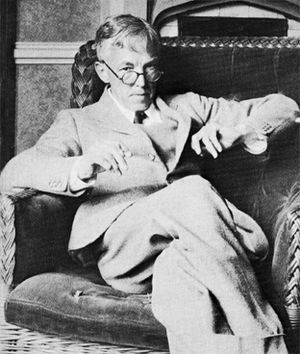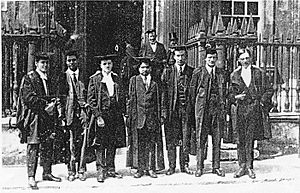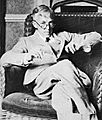G. H. Hardy facts for kids
Quick facts for kids
G. H. Hardy
|
|
|---|---|

Hardy, c. 1927
|
|
| Born |
Godfrey Harold Hardy
7 February 1877 Cranleigh, Surrey, England
|
| Died | 1 December 1947 (aged 70) Cambridge, Cambridgeshire, England
|
| Nationality | British |
| Alma mater | Trinity College, Cambridge |
| Known for | Hardy–Weinberg principle Hardy–Ramanujan asymptotic formula Critical line theorem Hardy–Littlewood tauberian theorem Hardy space Hardy notation Hardy–Littlewood inequality Hardy's inequality Hardy's theorem Hardy–Littlewood circle method Hardy field Hardy–Littlewood zeta-function conjectures |
| Awards | Fellow of the Royal Society Smith's Prize (1901) Royal Medal (1920) De Morgan Medal (1929) Chauvenet Prize (1932) Sylvester Medal (1940) Copley Medal (1947) |
| Scientific career | |
| Fields | Mathematics |
| Institutions | Trinity College, Cambridge New College, Oxford |
| Academic advisors | A. E. H. Love E. T. Whittaker |
| Doctoral students | Mary Cartwright I. J. Good Edward Linfoot Cyril Offord Harry Pitt Richard Rado Robert Rankin Donald Spencer< Tirukkannapuram Vijayaraghavan E. M. Wright |
| Other notable students | Sydney Chapman Edward Titchmarsh Ethel Newbold |
| Influences | Camille Jordan |
| Influenced | Srinivasa Ramanujan |
Godfrey Harold Hardy (born February 7, 1877 – died December 1, 1947) was a famous English mathematician. He was known for his important work in areas like number theory and mathematical analysis. In biology, he is remembered for the Hardy–Weinberg principle. This is a basic rule in population genetics that helps us understand how genes change in a group of living things.
Many people outside of mathematics know G. H. Hardy for his 1940 book, A Mathematician's Apology. This book is seen as one of the best ways to understand how a mathematician thinks and works.

Starting in 1914, Hardy became a mentor to the amazing Indian mathematician Srinivasa Ramanujan. This friendship became very famous. Hardy quickly saw that Ramanujan was incredibly smart, even though he hadn't had much formal training. They became close friends and worked together on many projects. Hardy once said that finding Ramanujan was his greatest contribution to mathematics. He also called their connection "the one romantic incident in my life."
Contents
Early Life and Education
G. H. Hardy was born on February 7, 1877, in Cranleigh, England. His parents were both teachers and were good at math, even though they didn't go to university.
Hardy showed a natural talent for mathematics from a very young age. When he was only two years old, he could write numbers up to millions. In church, he would entertain himself by finding the factors of the hymn numbers.
After attending Cranleigh School, Hardy won a scholarship to Winchester College because of his math skills. In 1896, he went to Trinity College, Cambridge. After just two years, he did very well in the difficult Mathematical Tripos exam. Later, he wanted to change this exam system. He felt it focused too much on just passing the test, rather than truly learning math. While at university, Hardy joined a special intellectual group called the Cambridge Apostles.
Hardy said that a big influence on him was studying a book by the French mathematician Camille Jordan. This book helped him learn about the more exact and careful way math was done in Europe. In 1900, he became a Fellow at Trinity College. He earned his M.A. degree in 1903, which was the highest degree back then. In 1906, he became a math lecturer at Trinity. This job gave him plenty of time to do his own research.
In 1919, Hardy moved to Oxford to become a professor there. He returned to Cambridge in 1931 and continued teaching math until 1942.
Hardy's Contributions to Mathematics
Hardy is known for making British mathematics more precise and strict. Before him, British mathematicians often focused on applied mathematics, like the work of Isaac Newton. Hardy, however, was more interested in pure mathematics. He strongly promoted this idea, especially against the study of fluid movement which was popular at Cambridge.
From 1911, Hardy worked closely with John Edensor Littlewood. They did a lot of important work in mathematical analysis and analytic number theory. Their work helped solve problems like Waring's problem. They also made progress in understanding prime numbers. Their partnership is one of the most famous and successful in math history. A mathematician once joked that there were three great English mathematicians: Hardy, Littlewood, and Hardy–Littlewood!
Hardy is also famous for creating the Hardy–Weinberg principle in 1908. He developed this idea about population genetics at the same time as Wilhelm Weinberg. Hardy played cricket with a geneticist named Reginald Punnett, who explained the problem to him in math terms. Hardy wasn't very interested in genetics and thought the math was "very simple." He might not have known how important his discovery would become.
Hardy's collected writings have been published in seven books.
Pure Mathematics and Its Purpose
Hardy preferred his math to be seen as pure mathematics. This might have been because he disliked war and how math was used for military purposes.
However, even though he wanted his math to be "pure," some of his work has been very useful in other sciences. For example, his work with Ramanujan on integer partitions has been used in physics. It helped scientists like Niels Bohr understand how atomic nuclei work.
In his book Apology, Hardy explained that mathematicians don't usually "glory in the uselessness of their work." Instead, he said that because science can be used for both good and bad, mathematicians might be happy that their field is "gentle and clean" because it's far from everyday human activities. Hardy also said it was wrong to think that pure and applied mathematics were different because of how useful they were. He believed "pure" math was independent of the physical world. But he also thought some "applied" mathematicians, like Maxwell and Einstein, were "real" mathematicians. He felt their work had lasting beauty and could bring joy to many people for thousands of years.
Hardy's Personality and Interests
Hardy was part of the Bloomsbury group, a famous group of writers and thinkers. He was friends with people like G. E. Moore, Bertrand Russell, and J. M. Keynes. He loved cricket very much. Keynes once said that if Hardy had paid as much attention to the stock market as he did to cricket scores, he would have become very rich!
He was sometimes involved in politics, like joining the Union of Democratic Control during World War I.
Hardy was a lifelong bachelor. In his later years, his sister took care of him. He also had a few close friendships with young men who shared his interests, especially cricket. One of these friends was the writer C. P. Snow.
Hardy was very shy as a child. He remained socially awkward and a bit strange throughout his life. He was often the best student in his classes but hated getting prizes in front of everyone. He felt uncomfortable meeting new people and couldn't even look at himself in a mirror. People say he would cover all the mirrors with towels when he stayed in hotels.
The writer Paul Hoffman shared some of Hardy's funny New Year's resolutions. They included proving the Riemann hypothesis, scoring high in a cricket match, finding a way to prove God doesn't exist, climbing Mount Everest, becoming president of a new country, and even murdering Mussolini!
Hardy's Famous Sayings
Hardy had many interesting thoughts about mathematics and life. Here are a few:
- It's not worth a top person's time to just agree with what most people think. Many others can do that.
- A mathematician, like an artist or a poet, creates patterns. Their patterns last longer because they are made with ideas.
- We've decided that simple math is usually useful, but real, deep math is usually not.
- Great mathematicians like Galois, Abel, Ramanujan, and Riemann did their best work when they were young. Hardy believed that major new math ideas usually don't come from people over fifty.
- Hardy once told Bertrand Russell, "If I could prove by logic that you would die in five minutes, I would be sad you were dying, but my sadness would be much less because of the joy in the proof."
- A chess problem is real math, but it's "trivial" math. Even if it's clever, it's not important. The best math is serious and beautiful.
Images for kids
See also
 In Spanish: Godfrey Harold Hardy para niños
In Spanish: Godfrey Harold Hardy para niños



